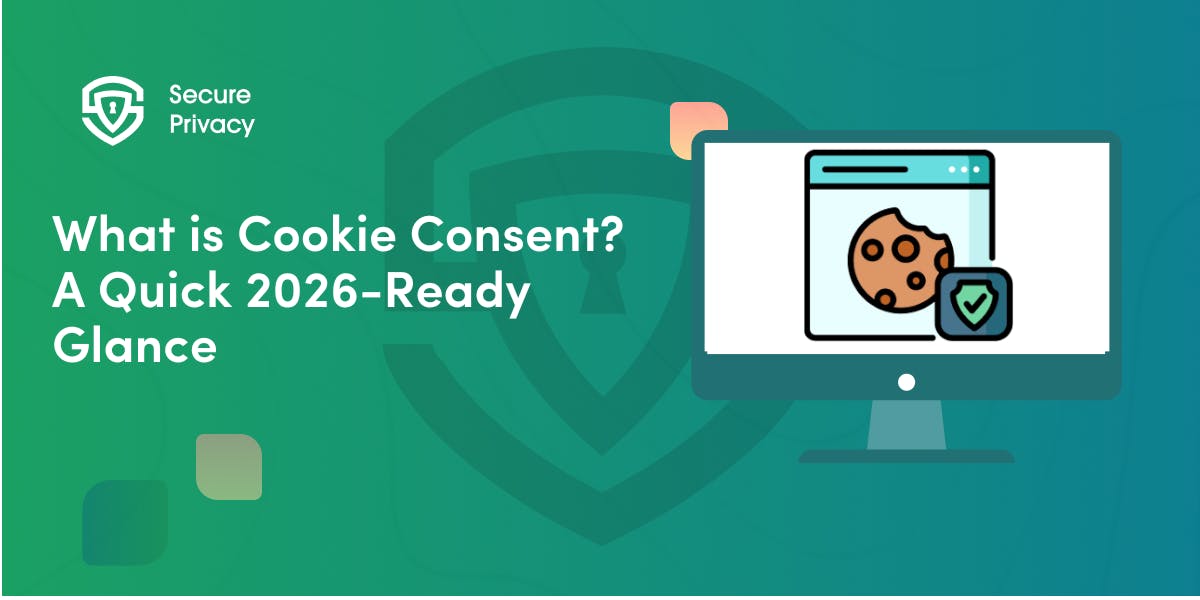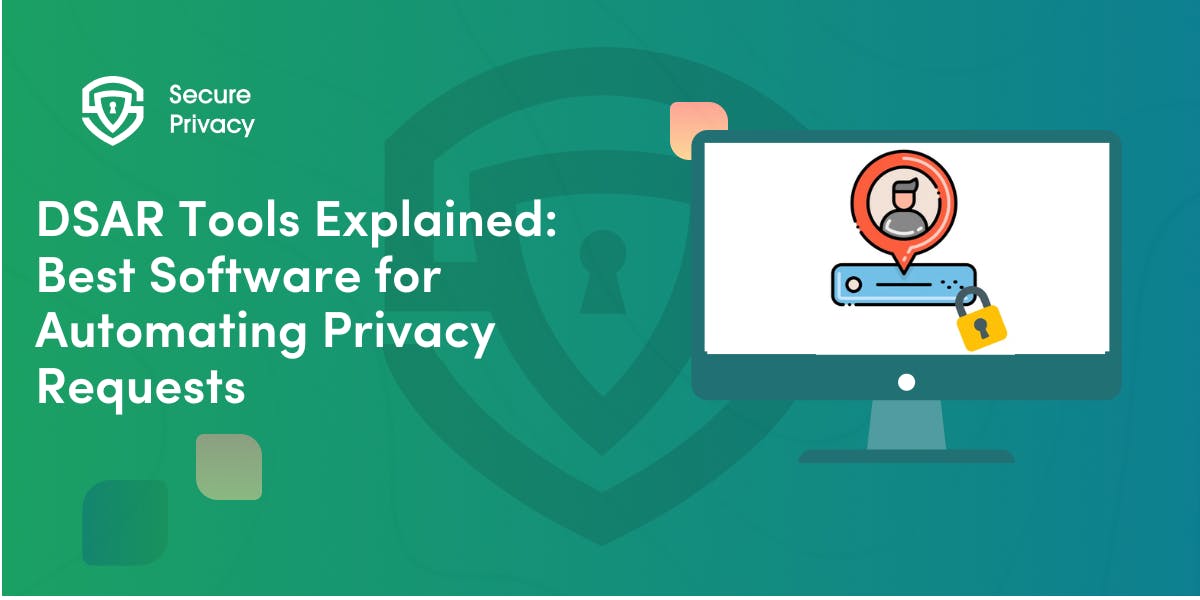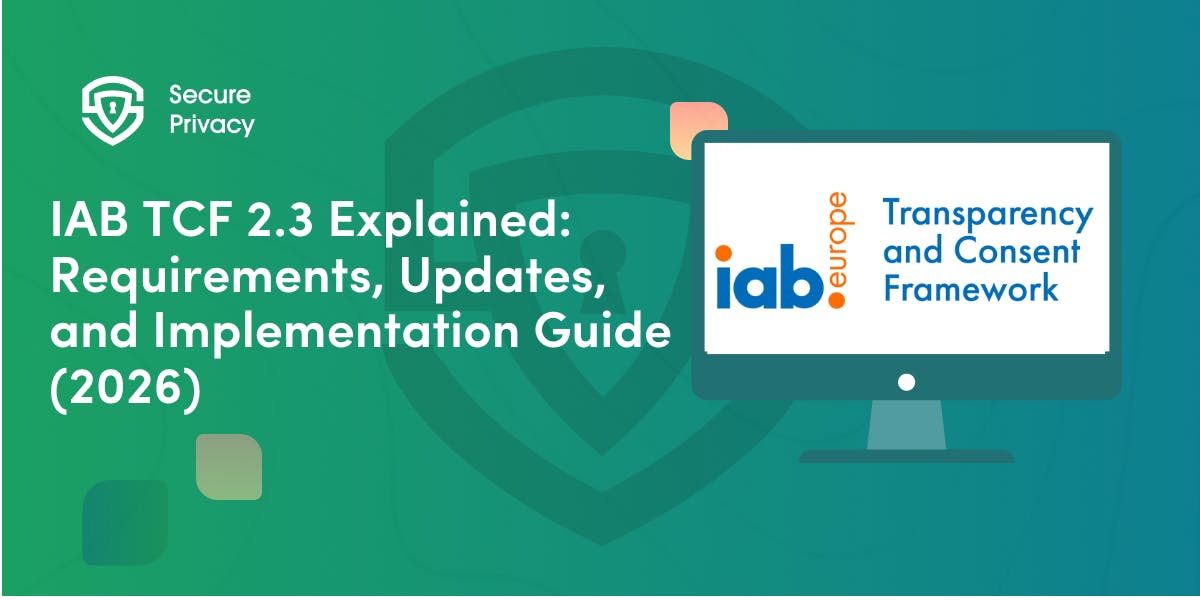Cross-Domain Cookie Consent: Complete Implementation Guide
Cross-domain cookie consent is a vital solution for companies managing multiple websites, subdomains, or digital properties under one corporate umbrella. Without proper implementation, users face repetitive consent banners as they move between related sites, creating friction and potentially exposing organizations to compliance risks.
This guide explains the technical, legal, and user experience factors for implementing effective multi-domain cookie consent strategies that meet regulatory requirements while maintaining smooth user journeys across digital properties.

Prioritizing user privacy is essential. Secure Privacy's free Privacy by Design Checklist helps you integrate privacy considerations into your development and data management processes.
The Challenge of Cross-Domain Consent
Modern businesses operate complex digital systems spanning multiple domains, subdomains, and regional websites. Each domain traditionally works as an isolated consent environment, creating significant user experience and compliance challenges.
Technical Limitations of Traditional Cookie Management
Domain Isolation: Browsers restrict cookie access to the originating domain by default, preventing consent preferences from transferring between separate domains or even subdomains without proper configuration.
Third-Party Cookie Restrictions: Modern browsers increasingly block third-party cookies, limiting traditional cross-domain tracking methods and requiring new approaches to consent persistence across domains.
Subdomain Complexity: Even closely related subdomains like shop.example.com and support.example.com require specific configuration to share consent preferences effectively through cookie banner across subdomains implementation.
User Experience Impact
Banner Fatigue: Users encounter multiple consent requests as they navigate between related domains, leading to frustration and potential abandonment.
Inconsistent Preferences: Without synchronization, users must manage privacy preferences separately for each domain, creating confusion and compliance challenges.
Conversion Impact: Repetitive consent interruptions can significantly impact conversion rates, particularly for e-commerce flows spanning multiple domains.
Business and Compliance Risks
Regulatory Violations: Fragmented consent management may violate GDPR's requirement for informed, specific consent and CCPA's transparency obligations through inadequate GDPR/CCPA cookie compliance multi-site implementation.
Operational Inefficiency: Managing separate consent implementations across multiple domains increases administrative overhead and compliance monitoring complexity.
Data Quality Issues: Inconsistent consent collection affects data analytics accuracy and marketing attribution across digital properties.
Compliance Context for Multi-Domain Cookie Consent
Privacy regulations impose strict requirements on consent collection and management that directly impact implementations.
GDPR Requirements for Cross-Domain Consent
Informed Consent: Users must understand that consent applies across multiple domains, requiring clear disclosure of all domains included in the consent scope.
Specific Consent: Each processing purpose must receive explicit consent, and this specificity must be maintained across all domains in the consent group.
Withdrawable Consent: Users must be able to withdraw consent as easily as they provided it, requiring consistent withdrawal mechanisms across all domains.
Documented Consent: Organizations must maintain comprehensive records of consent collection, including which domains were covered and when consent was provided.
CCPA and CPRA Considerations
Transparent Data Sharing: California privacy laws require clear disclosure when personal information is shared or sold across domains or to third parties.
Opt-Out Mechanisms: "Do Not Sell or Share My Personal Information" preferences must be respected consistently across all domains in the organization's ecosystem.
Global Privacy Control: Automated privacy signals must be recognized and honored across all domains, requiring technical synchronization capabilities.
International Compliance Challenges
Jurisdictional Differences: Organizations operating globally must accommodate different consent requirements across jurisdictions while maintaining user experience consistency.
Regional Consent Variations: Some regions may require stricter consent standards than others, necessitating flexible implementations.
Technical Approaches to Cross-Domain Cookie Consent
Several technical methods enable consent sharing across domains, each with distinct advantages, limitations, and implementation requirements for effective multi-domain cookie consent.
Method 1: Subdomain Consent Sharing
Implementation: Configure consent cookies to be set on the parent domain (e.g., .example.com) making them accessible to all subdomains automatically through cookie banner across subdomains functionality.
Technical Requirements:
- Deploy identical CMP configurations across all subdomains
- Set consent cookies with appropriate domain scope
- Ensure consistent cookie categorization and purposes
- Implement unified privacy policy references
Advantages: Simple implementation, reliable browser support, immediate synchronization across subdomains.
Limitations: Only works for subdomains of the same parent domain, not effective for completely separate domains.
Best Use Cases: Organizations with subdomain-based architecture.
Method 2: Centralized Consent API
Implementation: Store consent preferences in a centralized consent management database accessible via API, synchronizing preferences when users navigate between domains.
Technical Requirements:
- Develop or integrate consent storage API
- Implement user identification mechanisms
- Create synchronization workflows
- Establish secure authentication for API access
Advantages: Works across completely separate domains, provides comprehensive consent auditing, supports complex consent scenarios.
Limitations: Requires custom development, depends on user identification, may face browser restrictions on cross-domain requests.
Best Use Cases: Organizations with authenticated user experiences or complex multi-brand architectures, cross-device synchronization (like iOS + tvOS) ensuring consistent user preferences.
Method 3: CMP Cross-Domain Synchronization
Implementation: Utilize consent management platforms with built-in cross-domain CMP integration capabilities through iframe integration or dedicated synchronization subdomains.
Technical Requirements:
- Select CMP with cross-domain support
- Configure domain groups and sharing permissions
- Implement iframe-based synchronization
- Test cross-domain functionality across browsers
Advantages: Vendor-supported solution, reduced development requirements, ongoing compliance updates.
Limitations: Limited by browser third-party cookie restrictions, vendor lock-in, potential iframe blocking.
Best Use Cases: Organizations preferring vendor-managed solutions with standard requirements.
Method 4: Server-Side Consent State Management
Implementation: Manage consent state server-side and inject appropriate scripts and cookies based on stored preferences when pages load.
Advantages: Immune to browser cookie restrictions, provides complete control over consent logic, supports complex compliance scenarios.
Limitations: Requires significant development resources, depends on server-side user identification, complexity in implementation.
Best Use Cases: Large enterprises with complex compliance requirements and significant technical resources.
User Experience Considerations for Cross-Domain CMP Integration
Effective cross-domain CMP integration requires careful attention to user experience design that balances regulatory compliance with usability.
Preventing Banner Fatigue
Single Consent Collection: Users should encounter consent requests only once across all domains in the consent group, eliminating repetitive interruptions through proper implementation.
Progressive Disclosure: For complex consent scenarios, implement progressive disclosure that presents essential choices first with options to access detailed preferences.
Contextual Consent: When additional consent is required for specific features or domains, provide clear context explaining why new permissions are needed.
Ensuring Design Consistency
Unified Branding: Maintain consistent visual design, messaging, and interaction patterns across all consent interfaces in the domain group.
Language Standardization: Use identical terminology and explanations across domains to avoid user confusion about consent scope and implications.
Mobile Optimization: Ensure consent interfaces work consistently across devices and screen sizes for all domains in the consent group.
Managing Regional Consent Differences
Geolocation-Based Consent: Implement different consent flows based on user location while maintaining synchronization within regions.
Jurisdiction-Specific Options: Provide region-appropriate consent choices while synchronizing preferences across applicable domains.
Fallback Mechanisms: Establish fallback consent mechanisms for users whose location cannot be determined or who use privacy tools that interfere with geolocation.
Selecting a CMP for Cross-Domain Cookie Consent
Choosing the right consent management platform for implementation requires evaluation of technical capabilities, compliance features, and integration requirements.
Essential Cross-Domain Features
Native Domain Synchronization: Platform should provide built-in sharing without requiring custom development or third-party integrations.
Flexible Domain Grouping: Ability to configure domain groups with different consent scopes, allowing granular control over which domains share consent preferences.
API Integration Support: Robust APIs for integrating with existing systems and enabling custom synchronization workflows.
Browser Compatibility: Solutions that work effectively across different browsers and adapt to evolving privacy restrictions.
Compliance and Audit Capabilities
Multi-Jurisdiction Support: Platform should handle different regulatory requirements across jurisdictions while maintaining cross-domain functionality.
Comprehensive Audit Trails: Detailed logging of consent collection, modification, and withdrawal across all domains for regulatory compliance demonstration.
Proof of Consent: Ability to generate compliance reports showing valid consent collection across domain groups for regulatory inquiries.
Automated Compliance Updates: Regular updates to maintain compliance with evolving privacy regulations across all supported jurisdictions.
Implementation Guide for Centralized Consent Management
Successful implementation requires systematic planning, careful configuration, and thorough testing across all domains and user scenarios.
Phase 1: Planning and Architecture
Domain Mapping: Create comprehensive inventory of all domains, subdomains, and digital properties requiring consent management integration.
Consent Scope Definition: Determine which domains should share consent preferences and which require separate consent collection due to different legal entities or processing purposes.
Technical Architecture Planning: Select appropriate technical approach based on domain structure, user authentication patterns, and available technical resources.
Compliance Requirements Assessment: Identify specific regulatory requirements for each jurisdiction where domains operate.
Phase 2: Platform Configuration
CMP Setup: Configure consent management platform with domain groups, consent categories, and cross-domain synchronization settings.
Script Deployment: Install CMP scripts across all domains with consistent configuration parameters and domain-specific customizations as needed.
API Integration: Implement API connections for custom synchronization requirements or integration with existing user management systems.
Testing Environment: Establish testing procedures to verify functionality across different browsers, devices, and user scenarios.
Phase 3: Testing and Validation
Cross-Domain Functionality: Test consent collection on one domain and verify synchronization across all related domains in the consent group.
Browser Compatibility: Validate functionality across different browsers, including those with strict privacy settings or ad blockers enabled.
User Journey Testing: Test complete user journeys spanning multiple domains to ensure seamless consent experience without repetitive requests.
Compliance Validation: Verify that implementation meets regulatory requirements for all applicable jurisdictions and document compliance evidence.
Best Practices and Common Pitfalls
Effective cross-domain cookie consent implementation requires attention to both technical excellence and regulatory compliance while avoiding common implementation mistakes.
Implementation Best Practices
Centralized Record Keeping: Maintain comprehensive, centralized consent management records of consent collection across all domains for audit and compliance purposes.
Regular Testing: Implement automated testing to verify functionality continues working as browsers update and privacy restrictions evolve.
Clear Documentation: Document consent scope, domain coverage, and user rights clearly in privacy policies and consent interfaces.
Performance Monitoring: Monitor website performance impact of consent management implementation across all domains to ensure optimal user experience.
Staff Training: Train relevant teams on cross-domain functionality to ensure consistent implementation and troubleshooting capabilities.
Common Pitfalls to Avoid
Duplicate Consent Requests: Failing to properly configure cross-domain synchronization can result in users seeing multiple consent banners, violating user experience principles and potentially regulatory requirements.
Inconsistent Consent Categories: Using different cookie categories or processing purposes across domains creates confusion and may invalidate consent collection efforts.
Inadequate Browser Testing: Failing to test across different browsers can result in non-functional consent persistence across domains for significant user segments.
Poor Consent Withdrawal: Making consent withdrawal more difficult than consent provision violates regulatory requirements and creates user experience problems.
Insufficient Documentation: Failing to document which domains are covered by consent collection creates compliance risks and user confusion.
Monitoring and Optimization
Consent Rate Tracking: Monitor consent acceptance rates across domains to identify potential user experience issues or technical problems.
Compliance Monitoring: Regularly audit multi-domain cookie consent implementation to ensure continued regulatory compliance as laws evolve.
User Feedback Integration: Collect and respond to user feedback about consent experience across domains to continuously improve implementation.
Technical Performance Review: Regularly assess technical performance impact and optimize implementation to minimize website loading time impact.
Future Considerations for User Consent Synchronization
The landscape of cross-domain cookie consent management continues evolving as browsers implement stricter privacy controls and regulations become more sophisticated.
Browser Privacy Evolution
Third-Party Cookie Deprecation: Major browsers are eliminating third-party cookies, requiring alternative approaches to user consent synchronization.
Storage Partitioning: New browser features partition storage by site, affecting traditional cross-domain consent sharing mechanisms.
Privacy Sandbox: Google's Privacy Sandbox and similar initiatives may provide new mechanisms for privacy-compliant cross-domain cookie consent management.
Regulatory Development
Global Privacy Standards: Emerging international privacy standards may create opportunities for more standardized cross-domain approaches.
Enhanced Enforcement: Increasing regulatory enforcement may require more sophisticated consent documentation and audit capabilities.
New Consent Models: Regulatory developments may introduce new consent models that affect cross-domain CMP integration requirements.
Technical Innovation
API Standardization: Industry efforts to standardize consent APIs may simplify cross-domain implementation and improve interoperability.
Blockchain Solutions: Emerging blockchain-based consent management may provide new approaches to cross-domain consent verification and audit.
AI-Powered Consent: Artificial intelligence may enable more sophisticated consent prediction and management across complex domain structures.
Conclusion
Cross-domain cookie consent represents both a technical challenge and a business opportunity for organizations operating multiple digital properties. Effective implementation requires careful balance of user experience, technical feasibility, and regulatory compliance while preparing for continued evolution in privacy technology and regulation.
Organizations that invest in robust multi-domain cookie consent management position themselves for success in an increasingly privacy-conscious digital environment. The key lies in selecting appropriate technical approaches, implementing comprehensive centralized consent management frameworks, and maintaining user-centric design principles across all digital touchpoints.
Ready to implement seamless cross-domain cookie consent for your organization? Modern consent management platforms with built-in cross-domain synchronization eliminate technical complexity while ensuring comprehensive GDPR/CCPA cookie compliance multi-site across all your digital properties.
[Book a demo] to see how automated cross-domain cookie consent management can improve user experience while strengthening privacy compliance across your entire digital ecosystem.
Get Started For Free with the
#1 Cookie Consent Platform.
No credit card required

What is Cookie Consent? A Quick 2026-Ready Glance
Your website loads. Cookies track users. But without proper cookie consent, you're violating GDPR — risking fines up to €20 million or 4% of global revenue. Cookie consent is the legally required mechanism by which websites obtain explicit user approval before deploying non-essential tracking technologies. This requirement stems from GDPR Article 4(11) and the ePrivacy Directive, mandating that consent must be freely given, specific, informed, and unambiguous.
- Legal & News

DSAR Tools Explained: Best Software for Automating Privacy Requests
You're drowning in data subject access requests. Manual searches through dozens of systems miss regulatory deadlines and expose organizations to fines starting at $2,500 per violation. The solution? DSAR tools — purpose-built software that automates the entire process of responding to data subject access requests, from intake to delivery.
- Legal & News

IAB TCF 2.3 Explained: Requirements, Updates, and Implementation Guide (2026)
Your ad revenue dropped 40% overnight. Google stopped bidding on your inventory. Your DSP partners flagged your traffic as non-compliant. The culprit? An outdated TCF 2.2 consent string after the February 2026 enforcement deadline.
- Legal & News
- Cookie Consent
